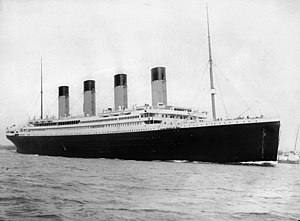
Back RMS Titanic Afrikaans ታይታኒክ Amharic Titanic AMI RMS Titanic ANG آر إم إس تيتانيك Arabic تيطانيك ARY الباخره تايتانيك ARZ আৰ. এম. এছ. টাইটানিক Assamese RMS Titanic AST Titanik Azerbaijani
 RMS Titanic departing Southampton on 10 April 1912
| |
 Location of Titanic wreck
| |
| History | |
|---|---|
| Name | RMS Titanic |
| Namesake | Titans |
| Owner | |
| Operator | White Star Line |
| Port of registry | |
| Route | Southampton to New York City |
| Ordered | 17 September 1908 |
| Builder | Harland and Wolff, Belfast |
| Cost | £1.5 million (£180 million in 2023) |
| Yard number | 401 |
| Way number | 400 |
| Laid down | 31 March 1909 |
| Launched | 31 May 1911 |
| Completed | 2 April 1912 |
| Maiden voyage | 10 April 1912 |
| In service | 10 April 1912 |
| Out of service | 15 April 1912 |
| Identification |
|
| Fate | Struck an iceberg at 11:40 pm (ship's time) 14 April 1912 on her maiden voyage and sank 2 h 40 min later on 15 April 1912 |
| Status | Wreck |
| General characteristics | |
| Class and type | Olympic-class ocean liner |
| Tonnage | 46,329 GRT, 21,831 NRT |
| Displacement | 52,310 tonnes |
| Length | 882 ft 9 in (269.1 m) overall |
| Beam | 92 ft 6 in (28.2 m) |
| Height | 175 ft (53.3 m) (keel to top of funnels) |
| Draught | 34 ft 7 in (10.5 m) |
| Depth | 64 ft 6 in (19.7 m) |
| Decks | 9 (A–G) |
| Installed power | 24 double-ended and five single-ended boilers feeding two reciprocating steam engines for the wing propellers, and a low-pressure turbine for the centre propeller;[3] output: 46,000 HP |
| Propulsion | Two three-blade wing propellers and one centre propeller |
| Speed |
|
| Capacity | 2,453 passengers and 874 crew (3,327 in total) |
| Notes | Lifeboats: 20 (sufficient for 1,178 people) |
RMS Titanic was a British ocean liner that sank in the early hours of 15 April 1912 as a result of striking an iceberg on her maiden voyage from Southampton, England, to New York City, United States. It was the second time White Star Line had lost a ship on its maiden voyage, the first being the RMS Tayleur in 1854. Of the estimated 2,224 passengers and crew aboard, approximately 1,500 died (figures vary), making the incident one of the deadliest peacetime sinkings of a single ship.[4] Titanic, operated by the White Star Line, carried some of the wealthiest people in the world, as well as hundreds of emigrants from the British Isles, Scandinavia, and elsewhere in Europe who were seeking a new life in the United States and Canada. The disaster drew public attention, spurred major changes in maritime safety regulations, and inspired a lasting legacy in popular culture.
RMS Titanic was the largest ship afloat upon entering service and the second of three Olympic-class ocean liners built for the White Star Line. The ship was built by the Harland and Wolff shipbuilding company in Belfast. Thomas Andrews Jr., the chief naval architect of the shipyard, died in the disaster. Titanic was under the command of Captain Edward John Smith, who went down with the ship.
The first-class accommodation was designed to be the pinnacle of comfort and luxury. It included a gymnasium, swimming pool, smoking rooms, fine restaurants and cafes, a Victorian-style Turkish bath, and hundreds of opulent cabins. A high-powered radiotelegraph transmitter was available to send passenger "marconigrams" and for the ship's operational use. Titanic had advanced safety features, such as watertight compartments and remotely activated watertight doors, which contributed to the ship's reputation as "unsinkable".
Titanic was equipped with sixteen lifeboat davits, each capable of lowering three lifeboats, for a total capacity of 48 boats. Despite this capacity, the ship was scantly equipped with a total of only twenty lifeboats. Fourteen of these were regular lifeboats, two were cutter lifeboats, and four were collapsible and proved difficult to launch while the ship was sinking. Together, the lifeboats could hold 1,178 people — roughly half the number of passengers on board, and a third of the number of passengers the ship could have carried at full capacity (a number consistent with the maritime safety regulations of the era). The British Board of Trade's regulations required fourteen lifeboats for a ship of 10,000 tonnes. Titanic carried six more than required, allowing 338 extra people room in lifeboats. When the ship sank, the lifeboats that had been lowered were only filled up to an average of 60%.
- ^ "Titanic History, Facts and Stories". Titanic Museum Belfast. Archived from the original on 6 January 2021. Retrieved 22 October 2018.
- ^ "Titanic Centenary". Newcastle University Library. Archived from the original on 6 January 2021. Retrieved 22 October 2018.
- ^ Beveridge & Hall 2004, p. 1.
- ^ "R.M.S Titanic". National Oceanic and Atmospheric Administration. 31 May 1911. Retrieved 3 September 2024.